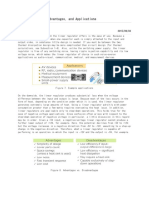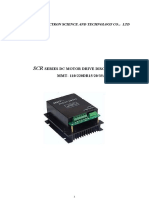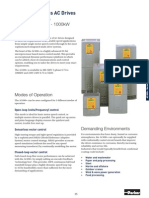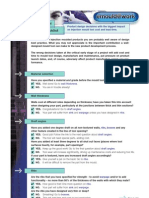Stepper Motor Is The Best For Moving A Wheel Exactly 90 Degrees. Because Usually There Are
Stepper Motor Is The Best For Moving A Wheel Exactly 90 Degrees. Because Usually There Are
Uploaded by
Zul NazimCopyright:
Available Formats
Stepper Motor Is The Best For Moving A Wheel Exactly 90 Degrees. Because Usually There Are
Stepper Motor Is The Best For Moving A Wheel Exactly 90 Degrees. Because Usually There Are
Uploaded by
Zul NazimOriginal Description:
Original Title
Copyright
Available Formats
Share this document
Did you find this document useful?
Is this content inappropriate?
Copyright:
Available Formats
Stepper Motor Is The Best For Moving A Wheel Exactly 90 Degrees. Because Usually There Are
Stepper Motor Is The Best For Moving A Wheel Exactly 90 Degrees. Because Usually There Are
Uploaded by
Zul NazimCopyright:
Available Formats
Question :
2. Stepper motor is the best for moving a wheel exactly 90 degrees. Because Usually there are
four phases at 90 degree intervals so when one comes down to zero, the next one has reached
maximum. This is a benefit as it means the output can be rectified to produce much smoother
DC with hardly any gaps, but it means they have a scarily large number of wires coming out.
DISCUSSION :
1. State two advantges and one disadvantagesof a relayas an interface device.
i) Advantages
One-stop offering: Wide choice from a complete range with several designs for a variety
of applications
Save time for installation and maintenance by pin bases snapping on top hat rails
For medium or low switching frequency many times more cost-effective
alternative compared to semiconductors Insensitive to over current/overvoltage
Latching relays: Energy-saving solution for applications with desired latching properties,
the stored condition is kept even after removal of the control pulse or voltage drops.
ii) Disadvantages
When closed, higher resistance (generating heat), and increased electrical noise
When open, lower resistance, and reverse leakage current (typically A range)
Voltage/current characteristic is not linear (not purely resistive), distorting switched
waveforms to some extent. An electromechanical relay has the low ohm (linear)
resistance of the associated mechanical switch when activated, and the exceedingly
high resistance of the air gap and insulating materials when open.
Some types have polarity-sensitive output circuits. Electromechanical relays are not
affected by polarity.
2)Compare advantages and dis advantages between DC motor and stepper motor.
ADVANTAGE DISADVANTAGE
DC MOTOR
High Torque, easy speed
(change the voltage) and
torque control (just limit
current)
Expensive to produce,
physically larger, high
maintenance(brushes)
STEPPER MOTOR
Can work in an open
loop (no feedback
required)
Excellent holding torque
(eliminated
brakes/clutches)
Excellent torque at low
speeds
Low maintenance
(brushless)
Very rugged - any
environment
Excellent for precise
positioning control
Rough performance at
low speeds unless you
use micro stepping For
more information about
micro stepping, see
the Stepper Motor
Switching Sequence link
below)
Consume current
regardless of load
Limited sizes available
Noisy
Torque decreases with
speed (you need an
oversized motor for
higher torque at higher
speeds)
Stepper motors can stall
or lose position running
without a control loop
REFLECTION:
Through this experiment, I have learned the interface of the PIC with a DC motor, stepper motor
and write the program to control DC motor and stepper motor.i also able to write the coding for
the question and I learn the stepper motor have many advantages than DC motor . I also learn
to write a program with 1 input and 2 output .
You might also like
- Caterpiller 3508 SettingsDocument11 pagesCaterpiller 3508 SettingsHalit Yalçınkaya88% (16)
- 454 GT Series: ID-PWM AC Low Voltage Variable Frequency DrivesDocument12 pages454 GT Series: ID-PWM AC Low Voltage Variable Frequency DrivesVicente Orbegoso RodriguezNo ratings yet
- Module 1.the Domain of Production and Operations Management (Operations Management) - Opem 311Document8 pagesModule 1.the Domain of Production and Operations Management (Operations Management) - Opem 311Maritoni Medalla100% (2)
- Direct Current (DC) Motors: OperationDocument6 pagesDirect Current (DC) Motors: OperationckyprianouNo ratings yet
- Catalogo GERAPID GE PDFDocument48 pagesCatalogo GERAPID GE PDFfassina01100% (1)
- Elements of Microcontroller Ecosystem, Power Supply For ESDocument38 pagesElements of Microcontroller Ecosystem, Power Supply For ESAmbuj Singh KushwahaNo ratings yet
- Industrial Motor ControlDocument12 pagesIndustrial Motor Controlganesh madhav kendreNo ratings yet
- G8000MM - Brochure 120408 PDFDocument6 pagesG8000MM - Brochure 120408 PDFogautierNo ratings yet
- Motor Control Circuit DesignDocument21 pagesMotor Control Circuit Designwwr.tonboomzNo ratings yet
- M542 Stepper Motor DriveDocument8 pagesM542 Stepper Motor DriveElvio JungesNo ratings yet
- Kelly H PM User ManualDocument20 pagesKelly H PM User ManualmanmonbhaNo ratings yet
- MatrixDocument37 pagesMatrixmssurajNo ratings yet
- Stepper Motor Basics: Applicationnote001Document13 pagesStepper Motor Basics: Applicationnote001shark seas100% (1)
- Advantages Vs DisadvantagesDocument5 pagesAdvantages Vs DisadvantagesAnuar PadeliNo ratings yet
- Voltage Influence On Typical Protection and Controls ForDocument22 pagesVoltage Influence On Typical Protection and Controls ForM Kumar MarimuthuNo ratings yet
- Kaizen - Motor Selection GuideDocument10 pagesKaizen - Motor Selection GuideKarrar HussainNo ratings yet
- Earth Fault Relay in A Single Phase Power System.Document31 pagesEarth Fault Relay in A Single Phase Power System.Soumya Bhattacharya100% (2)
- AD Product Brochure-EnDocument4 pagesAD Product Brochure-EnMohamed AlkharashyNo ratings yet
- Power Flex 7000Document25 pagesPower Flex 7000Felipe Rene AucailleNo ratings yet
- Stepper Motor: By: Raghav AggarwalDocument8 pagesStepper Motor: By: Raghav AggarwalRaghav AggarwalNo ratings yet
- Electronic Slot Car Controller Mysteries Revealed - JayGee RacingDocument13 pagesElectronic Slot Car Controller Mysteries Revealed - JayGee RacingBeen DeeNo ratings yet
- Doc-Speed Control of A DC Motor Using Micro Controller 8051Document21 pagesDoc-Speed Control of A DC Motor Using Micro Controller 8051Mohit Keshri100% (1)
- MV7000Document12 pagesMV7000Tufan MaityNo ratings yet
- 2 Marks 1. Mention The Types of BrakingDocument6 pages2 Marks 1. Mention The Types of BrakingJoe SylvineNo ratings yet
- Laing Solar PumpDocument4 pagesLaing Solar PumpDena SnyderNo ratings yet
- Datasheet - M542H Stepper Motor DriverDocument10 pagesDatasheet - M542H Stepper Motor DriversthollanderNo ratings yet
- Low Voltage Switchgear PDFDocument12 pagesLow Voltage Switchgear PDFchidambaram kasiNo ratings yet
- Sri Shakthi Institute of Engg and Technology: Two Marks Questions and AnswersDocument12 pagesSri Shakthi Institute of Engg and Technology: Two Marks Questions and AnswersdhivyadevinNo ratings yet
- Lab Report 11Document8 pagesLab Report 11razakhan5114No ratings yet
- Sinamics v20 enDocument18 pagesSinamics v20 enPhúcMậpNo ratings yet
- Sag SwellDocument149 pagesSag Swellfurqan mahmudNo ratings yet
- NDC SheetDocument2 pagesNDC SheetAr RadzNo ratings yet
- View PDFDocument6 pagesView PDFpradeep.esg8068No ratings yet
- ATESS ESS Products PresentationDocument54 pagesATESS ESS Products PresentationAlfredo LechinNo ratings yet
- Variador Yanwa AcerosDocument9 pagesVariador Yanwa Acerosjuan Carlos GonzalezNo ratings yet
- KW948MANUALDocument7 pagesKW948MANUALyarizadehNo ratings yet
- Drv8825 DriveDocument9 pagesDrv8825 DriveSimone MolinaroNo ratings yet
- Sprint Single Phase DC DrivesDocument16 pagesSprint Single Phase DC DrivesNelson P. ColoNo ratings yet
- Solar PcsDocument6 pagesSolar Pcsharshad_soni7912No ratings yet
- Industrial Electronics CbcgsDocument26 pagesIndustrial Electronics Cbcgshadesg895No ratings yet
- V T V5-H High Performance Sensorless Vector Control Variable Speed Drive ManualDocument166 pagesV T V5-H High Performance Sensorless Vector Control Variable Speed Drive ManualLeandroNo ratings yet
- User's Manual: Step Motor DriverDocument20 pagesUser's Manual: Step Motor DriverAdalmi Santos SilvaNo ratings yet
- Applied Motion 3540moDocument10 pagesApplied Motion 3540moPham TruongNo ratings yet
- Switched Reluctance GeneratorsDocument4 pagesSwitched Reluctance GeneratorsOrphiac IncNo ratings yet
- Pavan Kumar Mini ProjectDocument53 pagesPavan Kumar Mini ProjectPavankumar KalliNo ratings yet
- Aqw PDFDocument5 pagesAqw PDFnjmnjkNo ratings yet
- V5-H Sensorless Vector Control Frequency Inverter ManualDocument168 pagesV5-H Sensorless Vector Control Frequency Inverter ManualRuben EscobarNo ratings yet
- Noliac PAD DatasheetDocument15 pagesNoliac PAD DatasheetBercea MihaiNo ratings yet
- Emerson - BRAVO Inverter Data SheetDocument2 pagesEmerson - BRAVO Inverter Data SheetOscar ReyesNo ratings yet
- Pavan Kumar Mini ProjectDocument53 pagesPavan Kumar Mini ProjectPavankumar KalliNo ratings yet
- Eletrical Motor OffshoreDocument38 pagesEletrical Motor OffshoreandreisraelNo ratings yet
- ABB ACS550 Drives CatalogueDocument16 pagesABB ACS550 Drives CatalogueAnonymous hXUhpe7S100% (1)
- Solar Inverters HitachiDocument8 pagesSolar Inverters HitachiBijuNo ratings yet
- Hydraulic Jack Motorised 2015Document57 pagesHydraulic Jack Motorised 2015Chockalingam Athilingam100% (3)
- Kaizen - Motor Selection GuideDocument11 pagesKaizen - Motor Selection GuideAmory Sabri AsmaroNo ratings yet
- Stepper Motor: Program Studi Mekatronika Politeknik Mekatronika Sanata Dharma 2014Document33 pagesStepper Motor: Program Studi Mekatronika Politeknik Mekatronika Sanata Dharma 2014Klemens Reynaldo100% (1)
- Brochure-Substation Protection & Control V1.1Document12 pagesBrochure-Substation Protection & Control V1.1Bilal HamadNo ratings yet
- STPTL Us12 24exp Dus132533wDocument4 pagesSTPTL Us12 24exp Dus132533wHector RomeroNo ratings yet
- 3G3RV V1Document76 pages3G3RV V1Omiga HatemNo ratings yet
- Integrator Series AC DrivesDocument9 pagesIntegrator Series AC Drivesjohxav10No ratings yet
- Balaji Institute of Technology and Sciences Balaji Nagar, Lingapuram, ProddaturDocument18 pagesBalaji Institute of Technology and Sciences Balaji Nagar, Lingapuram, ProddaturSuganthiVasanNo ratings yet
- VRV Integration With: Ahu For Special ApplicationsDocument4 pagesVRV Integration With: Ahu For Special ApplicationsDhirendra Singh RathoreNo ratings yet
- Electrode Booklet F Web 100Document1 pageElectrode Booklet F Web 100satnamNo ratings yet
- Compresor Gas Vru 7CDL 37-1-614Document55 pagesCompresor Gas Vru 7CDL 37-1-614Rohuder Andres LdsNo ratings yet
- Manometro DiferencialDocument4 pagesManometro Diferencialsoliveirajr01No ratings yet
- TDS 10566050 EN EN Easy-Mix-RK-7100 PDFDocument1 pageTDS 10566050 EN EN Easy-Mix-RK-7100 PDFKJ SupplyNo ratings yet
- External Plaster WorkDocument6 pagesExternal Plaster Workkmandar99100% (1)
- Fan Pulley Selection GuideDocument2 pagesFan Pulley Selection GuideSatish MishraNo ratings yet
- TDS - Pidicryl 126MDocument2 pagesTDS - Pidicryl 126MLaura Isabel RodriguezNo ratings yet
- Renderoc PlugDocument2 pagesRenderoc Plug0410636No ratings yet
- 4 SmawDocument39 pages4 SmawEngineerSajidAlamNo ratings yet
- Trane Condensing Unit PDFDocument112 pagesTrane Condensing Unit PDFridNo ratings yet
- Mapra q1Document16 pagesMapra q1julio.queridoNo ratings yet
- Spare Parts List WD290: CE 0044 Switzerland 2003 Item No. 73300 EDocument50 pagesSpare Parts List WD290: CE 0044 Switzerland 2003 Item No. 73300 EAndrea ReyesNo ratings yet
- Nano PpsDocument41 pagesNano PpsShravya SirigiriNo ratings yet
- RGB 8x8x8 Led CubeDocument24 pagesRGB 8x8x8 Led CubeRohan Chavan100% (1)
- Developing A Manufacturing-Based Economy in Nigeria Through Science and TechnologyDocument10 pagesDeveloping A Manufacturing-Based Economy in Nigeria Through Science and TechnologyFrezyGrantNo ratings yet
- FRC BetaflamDocument12 pagesFRC Betaflamdelly murtiNo ratings yet
- Fatigue LifA State-Of-The-Art Review On Fatigue Life Prediction Methods For Metal StructuresDocument14 pagesFatigue LifA State-Of-The-Art Review On Fatigue Life Prediction Methods For Metal StructuresMona AwadNo ratings yet
- Detailed Estimate & Abstract of Cost Part "A": Building WorkDocument7 pagesDetailed Estimate & Abstract of Cost Part "A": Building WorkSitaramgv VenkataNo ratings yet
- Bendable ConcreteDocument21 pagesBendable ConcreteJulia Sebastian0% (1)
- Instrumentation Cables: Product CatalogueDocument44 pagesInstrumentation Cables: Product Cataloguexinying liuNo ratings yet
- Manure Spreading Machine of 5 Tons Capacity, Mg-5 Masina Pentru Administrat Ingrasaminte Organice Solide, Cu Masa Utila de 5 Tone, Mg-5Document5 pagesManure Spreading Machine of 5 Tons Capacity, Mg-5 Masina Pentru Administrat Ingrasaminte Organice Solide, Cu Masa Utila de 5 Tone, Mg-5BaRoez THesaNo ratings yet
- Design and Construction of A Water Scrubber For The Upgrading of BiogasDocument7 pagesDesign and Construction of A Water Scrubber For The Upgrading of Biogasputri safitriNo ratings yet
- A4vg125 GBDocument12 pagesA4vg125 GBEdgar Huiman100% (2)
- ChecklistDocument3 pagesChecklistkannan100% (1)
- K4 BSP Adapters: The Fitting AuthorityDocument10 pagesK4 BSP Adapters: The Fitting AuthorityRungthiwaThaweesupNo ratings yet
- Product Distribution From Pyrolysis of Wood and Agricultural ResiduesDocument9 pagesProduct Distribution From Pyrolysis of Wood and Agricultural ResiduescokavoliNo ratings yet
























































































